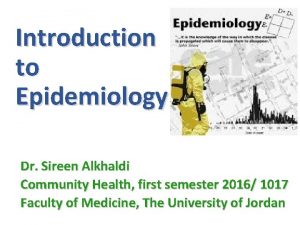Anemia prevalence and nutrition status among San women

- Slides: 1

Anemia prevalence and nutrition status among San women and children in rural Botswana Tebogo T. Leepile, Jennifer L. Black , Eduardo Jovel , and Crystal D. Karakochuk INTRODUCTION DISCUSSION § In Botswana, little is known about the health and nutritional status of the San People, an Indigenous minority group primarily living in Ghanzi District. § High prevalence of undernutrition among San women and young children. § Anemia ranged widely based on Hb adjustment factors, from 6 -26% in nonpregnant women, 22 -30% in pregnant women and 35 -63% in children. § Rates of anemia were higher in peri-urban areas compared to rural areas (women (20% vs. 11%) and children (51% vs. 40%). § Among children differences in malnutrition between the age groups were observed: o 6 -23 months, peri-urban-based children were the most affected compared with their counterparts in rural areas. o 24 -59 months, prevalence of child malnutrition higher among children in rural areas. OBJECTIVE § To assess the prevalence of anemia and nutritional status of San women and young children in Ghanzi District in rural Botswana. METHODS 1. Cross-sectional survey in nine randomly selected areas. 2. Analysis of Hemoglobin (Hb) concentration (Hemo. Cue) and anthropometrics (weight and height measurements), n=367 San mother-child pairs. 3. Anemia was determined by the WHO cut-offs (children and pregnant women, Hb <110 g/L, non-pregnant women Hb <120 g/L while BMI and z-scores (WHO growth reference) were used to assess the nutritional status of women and children respectively. San women and children are grappling with anemia, undernutrition, and growth faltering indicators; urgent attention is warranted. RESULTS § Large households (8. 5 4. 4 people). § Poverty (low incomes; 69% households live on <175 USD/month) and lack household toilets. Anemia Prevalence All Non-pregnant Pregnant Hb, g/L, mean SD 137 16 138 15 122 15 Prevalence, n (%) 48/367 (13%) 42/344 (12%) 6/23 (26%) Children All Rural Peri-urban Hb, g/L, mean SD 111 16 112 16 108 13 Prevalence, n (%) 153/367 (42%) 117/296 (40%) Values adjusted for altitude, ethnicity, and smoking 36/71 (51%) § To our knowledge, this is the first study to provide specific and comprehensive data on the Indigenous San People of Botswana. § These findings will elucidate future key priority areas and will inform and guide targeted nutrition and health policies. RESEARCH PARTNERS Hb, Anemia (n=367) Women GLOBAL HEALTH IMPLICATIONS 52% of pregnant women were underweight 13% of all women were anemic and 56% smoked 42% of children were anemic, 65% stunted, and 13% wasted i) Women: underweight (BMI <18. 5 kg/m 2) ii) Children; wasting (low weight-for-length/height, WLZ/WHZ <-2 SD), stunting (low length/height-for-age, LAZ/HAZ <-2 SD) Letloa Trust contact: tebogo. leepile@ubc. ca

